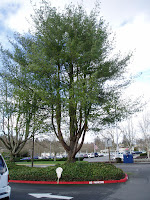 |
Sample site location (red arrow) in
relation to nearby Ozyptila praticola
collection sites |
There's nothing that beckons like a sun break in winter, especially when the thermometer hits 50 F! And since business took me to Mill Creek, a town I hadn't collected spiders in previously, I made sure to find an hour to tap some pine cones while there.
 |
| The tree, the ivy |
My cone source was a white pine tree. Whether eastern white pine (
Pinus strobus) or western (
P. monticola) I couldn't be sure because the bark wasn't well enough developed to tell. I've found both species planted in the urban landscapes of Pugetopolis. Whichever species it was, it was growing in a typical urban setting: surrounded by pavement and with an understory of pure English ivy (
Hedera helix).
 |
| A cone suspended in the ivy matrix |
I usually curse English ivy because, like the exotic invasive it is, it entirely snuffs out native plant species. But I must admit that it did serve several useful functions in this case. First, the dozens of cones that had fallen onto/into it escaped removal by groundskeepers. And second, the cones suspended in the ivy matrix, which was up to 2 feet thick in some places (!) were fairly dry even though it had rained the night before. Not so the cones I found on the ground, which tended to be muddy. So I can hardly complain about the presence of the ivy, at least under this particular tree.
 |
| The haul |
I tapped 50 fallen cones and collected 4 spiders, all juveniles. Two were likely
Ozyptila praticola (Thomisidae), the introduced crab spider that I'm working to determine the local distribution of. The others were a theridiid and a
Philodromus sp. (Philodromidae). Not an exciting catch, but it does serve as another point on the
O. praticola map. Or at least, a fuzzy point.
 |
| Beautiful pine foliage blowing in the wind |










No comments:
Post a Comment